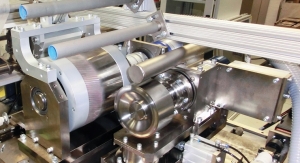03.26.19
Sonobond Ultrasonics offers a wide variety of ultrasonic rotary sewing machines, plunge welders, rotary cutters and hand cutters, in both stand-alone models and modular units that can be integrated into production lines. In addition to 500 standard pattern wheels, Sonobond can make custom tooling to achieve a customer’s specific application needs.
One new application using Sonobond technology is in the medical industry. The company’s machines work to ultrasonically assemble pouches that are used to hold medical and/or dental instruments as they go through their sterilization process, as well as to protect them while they are subsequently stored and/or transported for future use. “Our SeamMaster Ultrasonic Sewing Machines are typically used to seal the pouch edges with a strong, durable bond that can withstand the high temperatures of sterilization,” says Janet Devine, president of Sonobond.
Another new application for the company is in the industrial/cleanroom market. SeamMaster Ultrasonic Sewing Machines are also used to cut and seal the edges of special certified 99% lint free cleaning wipes, thereby eliminating any lint or particles which could cause problems with motors, sensitive devices or vehicles being prepped prior to priming or painting.
In addition to these areas, Sonobond technology is used for filters and filtration products, which is one of the company’s largest application areas. Its ultrasonic technology can bond fabrics that are 100% synthetic or blends that contain up to 40% natural fibers. HEPA, pleated, box style, heavy-duty industrial liquid and chemical filter bags, automotive air and oil filters, and vacuum bags can be assembled with Sonobond’s technology.
Medical disposables are another large application area for Sonobond Ultrasonics. This includes surgical gowns, caps, facemasks and booties, lint-free wound dressings and mattress covers. “Our machines’ high-frequency vibratory waves produce the sealed edges and secure seams without stitch holes, glue gaps, fraying or unraveling, thereby meeting OSHA’s tough regulatory requirements for barrier seams,” Devine says.
Sonobond’s SeamMaster Ultrasonic Sewing Machines operate like a traditional rotary sewing machine but produce soft, smooth seams that are impervious to moisture or fluids.
One application Devine considers a growing area for ultrasonics is for the assembly of body armor. Sonobond machines satisfy National Institute of Justice (NIJ) standards requiring body armor to be waterproof, even after submersion for 30 minutes. “Bulletproof materials contained in ballistic vests lose their life-saving effectiveness when exposed to water, so it’s imperative that the seams in the outer nylon shell are perfectly fused,” she says. “Both our SeamMaster – High Profile model – and our SureWeld Plunge Bonder reduce any risk of water or moisture damage to the ballistics materials inside the shell.”
Automotive door panels and insulation “blankets” used on aircraft are two applications also increasing their use of ultrasonic assembly machinery, according to Devine.
“Ultrasonic technology is ideally suited for nonwovens,” she says. “Cutting, trimming, edge-sealing, and seaming is faster and often cheaper than sewing or gluing. So, we anticipate contributing to pretty much any new nonwoven-based product assembly.”
One new application using Sonobond technology is in the medical industry. The company’s machines work to ultrasonically assemble pouches that are used to hold medical and/or dental instruments as they go through their sterilization process, as well as to protect them while they are subsequently stored and/or transported for future use. “Our SeamMaster Ultrasonic Sewing Machines are typically used to seal the pouch edges with a strong, durable bond that can withstand the high temperatures of sterilization,” says Janet Devine, president of Sonobond.
Another new application for the company is in the industrial/cleanroom market. SeamMaster Ultrasonic Sewing Machines are also used to cut and seal the edges of special certified 99% lint free cleaning wipes, thereby eliminating any lint or particles which could cause problems with motors, sensitive devices or vehicles being prepped prior to priming or painting.
In addition to these areas, Sonobond technology is used for filters and filtration products, which is one of the company’s largest application areas. Its ultrasonic technology can bond fabrics that are 100% synthetic or blends that contain up to 40% natural fibers. HEPA, pleated, box style, heavy-duty industrial liquid and chemical filter bags, automotive air and oil filters, and vacuum bags can be assembled with Sonobond’s technology.
Medical disposables are another large application area for Sonobond Ultrasonics. This includes surgical gowns, caps, facemasks and booties, lint-free wound dressings and mattress covers. “Our machines’ high-frequency vibratory waves produce the sealed edges and secure seams without stitch holes, glue gaps, fraying or unraveling, thereby meeting OSHA’s tough regulatory requirements for barrier seams,” Devine says.
Sonobond’s SeamMaster Ultrasonic Sewing Machines operate like a traditional rotary sewing machine but produce soft, smooth seams that are impervious to moisture or fluids.
One application Devine considers a growing area for ultrasonics is for the assembly of body armor. Sonobond machines satisfy National Institute of Justice (NIJ) standards requiring body armor to be waterproof, even after submersion for 30 minutes. “Bulletproof materials contained in ballistic vests lose their life-saving effectiveness when exposed to water, so it’s imperative that the seams in the outer nylon shell are perfectly fused,” she says. “Both our SeamMaster – High Profile model – and our SureWeld Plunge Bonder reduce any risk of water or moisture damage to the ballistics materials inside the shell.”
Automotive door panels and insulation “blankets” used on aircraft are two applications also increasing their use of ultrasonic assembly machinery, according to Devine.
“Ultrasonic technology is ideally suited for nonwovens,” she says. “Cutting, trimming, edge-sealing, and seaming is faster and often cheaper than sewing or gluing. So, we anticipate contributing to pretty much any new nonwoven-based product assembly.”
















